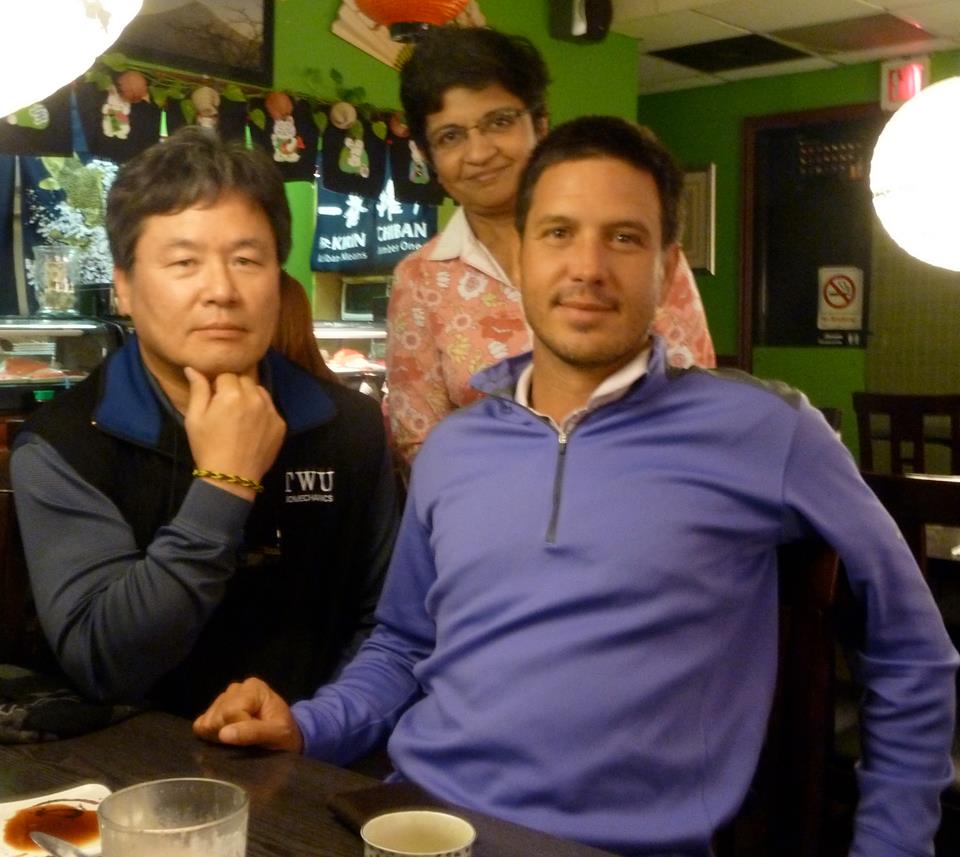www.golfbytourmiss.com welcomes Kiran Kanwar.
Kiran is no stranger to golf as she is one of the game’s most respected golf swing analysts. She also proudly holds the following distinctions:-
MS: Nutrition and Human Performance; Sports Science and Rehabilitation
The PGA (GB&I, Advanced Professional)
The PGA of India (Board Member)
National Golf Academy of India (Teaching Staff)
Columnist: Golf Digest
Member: Golf Writers’ Asscn. of America
Website: www.
Blog: www.minimalistgolfswingblog.
Hereunder is the first of Kiran’s articles for www.golfbytourmiss.com
‘BIOMECHANICS ‘- THE BUZZ WORK IN GOLF TODAY
by Kiran Kanwal
What is biomechanics and how can a golfer improve his/her golf

Kiran Kanwar (standing) havine dinner with Chris Como, the newly-appointed coach to Tiger Woods, and biomechanics guru Dr Young-Hoo Kwon.
swing by an understanding of, followed by an application of ‘biomechanics’?
Biomechanics is a term derived from ‘bio’ – referring to any living organism, and ‘mechanics’ – which concerns the structure and function of objects which are either ‘in a constant state of motion’ or are ‘subject to acceleration’.
Biomechanics is typically broken up into kinematics (study of the position or motion of an object – typically, the human being) and kinetics (study of the forces creating the motion). In other words, kinematics can be considered a study of the ‘effect’ of force application; and kinetics a study of the ‘causes’ of movement.
Sports biomechanics research helps us to ‘SEE’ better, with ideas for how to make motion Safe, Effective and Efficient.
‘Safety’ would require reducing loads on body-parts by changing the motion which is causing inappropriate compression, tension, shear or torque forces to act at the joints. Or, by increasing the endurance and tolerance of tissue by strengthening weak/inhibited muscles. Or by supporting areas prone to injury using external aids.
‘Effectiveness’ means maximization of output by suitable means. For the golf swing that would mean maximizing distance. This is best achieved by the use of external forces such as gravity or ground reaction force so that muscle-force requirement is reduced.
‘Efficiency’ comes from reducing muscle force and thus energy consumption (by the golfer), which would once again be possible through a better use of external forces.
All of the motion typically studied in biomechanics is either linear (movement in a straight line or curved line as with the golf ball) or angular (rotation around a fixed axis, such as the forearm around the elbow or the leg about the hip joint) or a combination of the two (such as a golf ball moving through the air in a curvi-linear path while rotating about an axis which gives it its the angular motion we know as ‘spin’.)
Basically, biomechanics helps to relate particular forces to specific motion, with the constraint to motion being the inertia or ‘reluctance to move’ of an object. As the constraint is reduced the motion can have greater speed/velocity and greater momentum/angular momentum (momentum simply means ‘quantity of motion’).
And, in the ultimate analysis that is all a golfer wants – to increase how fast his/her club travels and the quantity of motion it has, as it contacts the golf ball.
What about direction and distance? That’s a topic for another day.



